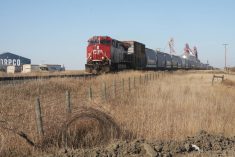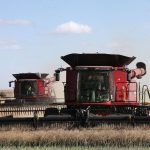Last summer’s weather resulted in low forage yields across Western Canada and an abnormally high accumulation of nitrate in many plants.
Not surprisingly, cases of nitrate poisoning in cattle fed nitrate-rich forages have increased during the winter feeding period.
Certain plants, including sorghum, oats, pigweed, beets, nightshade, corn, kochia, canola and Russian thistle are particularly susceptible to nitrate uptake.
Under stress from drought, heat, frost or disease, the upper parts of a plant may die but its roots continue to pull in nitrates from the soil.
Read Also

Agriculture needs to prepare for government spending cuts
As government makes necessary cuts to spending, what can be reduced or restructured in the budgets for agriculture?
The nitrate is no longer metabolized into protein, so it just accumulates. This process is exaggerated if the soil or water has a high nitrogen content.
Cows consume a certain amount of nitrate whenever they eat forage.
Once in the rumen, micro-organisms convert nitrate to nitrite, and then to ammonia. Though some ammonia is used by rumen flora, excess amounts are absorbed into the bloodstream and excreted in the urine as urea.
This system works effectively until cattle consume too much nitrate at once. The rumen bacteria that change nitrate to nitrite can handle the load but the organisms designated to convert nitrite to ammonia cannot keep up.
As a result, nitrite accumulates in the rumen and it is subsequently absorbed into the bloodstream. In the blood, nitrite binds with the oxygen-carrying molecules in red blood cells, called hemoglobin.
Because the converted hemoglobin, called methemoglobin, is incapable of carrying oxygen, many tissues become oxygen-deprived.
Signs of nitrate poisoning, which can develop within hours of eating high nitrate feed, reflect the animal’s state of oxygen deprivation. Most cattle breathe heavily as they try to take more oxygen into their lungs.
They are weak and staggering because their muscle cells are short of oxygen.
If you look at their gums and tongue, they are blue-grey instead of pink. If brain cells starve for oxygen, you can see convulsions.
If cattle consume enough nitrate fast enough, they can die without any visible signs of poisoning. Because nitrate poisoning typically occurs during the winter feeding period, it has an impact not only on cows, but also on their developing calves.
Pregnant cows may abort or they may produce weak, premature calves that die soon after birth.
Thin cattle are more likely to be stricken by nitrate poisoning than fat ones, partly because of competition at the feedbunk.
Stronger cows, in good condition, may eat the better quality feed because they can push weaker individuals away.
This leaves the less desirable, often the nit-rate-containing feed, for the thin cattle. Feeding once a day exaggerates this competition.
Cattle with respiratory problems are more likely to succumb to nitrates because they already have trouble getting enough oxygen into their bloodstreams.
A crude way to diagnose nitrate poisoning is to take a blood sample and look at its colour.
Normal blood is red but blood containing methemoglobin is chocolate-coloured.
This colour change only occurs when more than 30 percent of the body’s hemoglobin has been converted to methemoglobin.
The treatment for nitrate poisoning is an intravenous injection of methylene blue.
This chemical converts methemoglobin back to hemoglobin. Though this can be an effective treatment, it has some practical limitations. Few veterinarians have enough methylene blue on hand to treat an entire herd for nitrate poisoning.
As a result, only cattle that are likely to survive are treated.
Treatment success is also limited by the state of the animals when they are given methylene blue.
By the time a diagnosis is made, many cattle are severely affected and moving them into a chute and restraining them for an injection is likely to kill them.
In some cases, it is better to make an immediate feed change and then minimize oxygen demands by keeping the herd extremely quiet and avoiding all handling.
Jeff Grognet is a veterinarian and writer practising in Qualicum Beach, B.C.
















